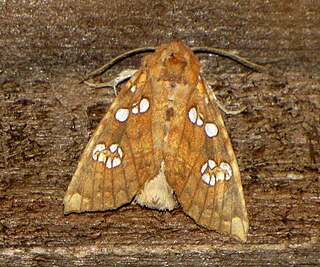
Moths are a group of insects that includes all members of the order Lepidoptera that are not butterflies. They were previously classified as suborder Heterocera, but the group is paraphyletic with respect to butterflies and neither subordinate taxa are used in modern classifications. Moths make up the vast majority of the order. There are thought to be approximately 160,000 species of moth, many of which have yet to be described. Most species of moth are nocturnal, although there are also crepuscular and diurnal species.

Crambidae comprises the grass moth family of lepidopterans. They are variable in appearance, with the nominal subfamily Crambinae taking up closely folded postures on grass stems where they are inconspicuous, while other subfamilies include brightly coloured and patterned insects that rest in wing-spread attitudes.

The Pyralidae, commonly called pyralid moths, snout moths or grass moths, are a family of Lepidoptera in the ditrysian superfamily Pyraloidea. In many classifications, the grass moths (Crambidae) are included in the Pyralidae as a subfamily, making the combined group one of the largest families in the Lepidoptera. The latest review by Eugene G. Munroe and Maria Alma Solis retain the Crambidae as a full family of Pyraloidea.

The Pyraloidea are a moth superfamily containing about 16,000 described species worldwide, and probably at least as many more remain to be described. They are generally fairly small moths, and as such, they have been traditionally associated with the paraphyletic Microlepidoptera.

Phymatopus is a genus of moths of the family Hepialidae, which consists of around 700 species and 82 genera. The genus was erected by Hans Daniel Johan Wallengren in 1869. They can be found across Eurasia and North America. Species can be distinguished by the different morphology of male genitalia and different forewing patterns, which vary in stripe colour and size and arrangement of spots. The stripes themselves consist of spots separated by dark veins which are fringed by thin black lines from both inner and outer sides.

Papaipema is a genus of moths of the family Noctuidae. The genus was erected by John B. Smith in 1899.

Walshia is a genus of moths in the family Cosmopterigidae.

Globia laeta, the red sedge borer, is a moth of the family Noctuidae. The species was first described by Herbert Knowles Morrison in 1875. It is found in North America, including Ohio, Illinois, New Jersey and Ontario.

Banisia myrsusalis, the sapodilla borer or sapota midrib folder, is a species of moth of the family Thyrididae. It was described by Francis Walker in 1859 and is found in North America, Brazil, Australia, southern Asia and Africa.
Walshia amorphella is a moth in the family Cosmopterigidae. It was described by James Brackenridge Clemens in 1864. It is found in North America, where it has been recorded from Illinois, Iowa, Kentucky, Minnesota and from Kansas to Texas.
Walshia dispar is a moth in the family Cosmopterigidae. It was described by Ronald W. Hodges in 1961. It is found in North America, where it has been recorded from Ontario to Virginia.
Walshia elegans is a moth in the family Cosmopterigidae. It was described by Ronald W. Hodges in 1978. It is found in North America, where it has been recorded from Florida, Louisiana, Arkansas, Iowa and West Virginia.
Walshia exemplata is a moth in the family Cosmopterigidae. It was described by Ronald W. Hodges in 1961. It is found in North America, where it has been recorded from Maryland, Arkansas, Indiana, Ohio, West Virginia, South Carolina, Mississippi, Louisiana and Florida.
Walshia particornella is a moth in the family Cosmopterigidae. It was described by August Busck in 1919. It is found in North America, where it has been recorded from Maryland, Illinois, Arkansas, Kentucky, Mississippi, Texas and Florida.
Walshia similis is a moth in the family Cosmopterigidae. It was described by Ronald W. Hodges in 1961. It is found in North America, where it has been recorded from Massachusetts, Michigan and from Illinois to South Carolina and Florida.
Walshia floridensis is a moth in the family Cosmopterigidae. It was described by Ronald W. Hodges in 1978. It is found in North America, where it has been recorded from Florida.
Triclonella pergandeella, the sweetclover root borer moth, is a moth in the family Cosmopterigidae. It is found in the United States, where it has been recorded from the District of Columbia, from Arkansas to Florida, Louisiana and Texas.
Comadia bertholdi, the lupine borer moth, is a moth in the family Cossidae. It is found in the United States, where it has been recorded from Washington, Colorado, Wyoming, Arizona, California, Nevada and New Mexico.
Syncopacma nigrella is a moth of the family Gelechiidae. It was described by Vactor Tousey Chambers in 1875. It is found in North America, where it has been recorded from Wyoming, Washington, California, Texas, Utah and Oklahoma.
Hydraecia immanis, the hop vine borer moth is a moth in the family Noctuidae native to North America. The species was described by Achille Guenée in 1852. It is listed as a species of special concern and is believed to be extirpated from the US state of Connecticut.









